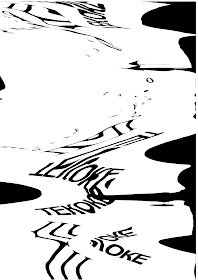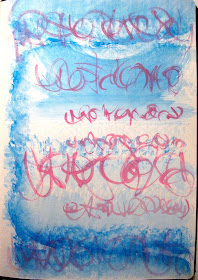This weblog explores asemic writing in relation to post-literate culture
Thursday, February 28, 2013
Tuesday, February 26, 2013
Monday, February 25, 2013
Thursday, February 21, 2013
Wednesday, February 20, 2013
Printing Test Plates from Christopher Skinner
These are test pieces for the soft ground etching process. These are produced every so often to test the quality of the ground, strength of acid and exposure time in order to create the best printing plate. Then the plates are used to aid setting up the correct pressure between the rollers of the press, the receptiveness of the paper and quality of the printed line. These say so much more to me though.
Tuesday, February 19, 2013
Mail art project: "signs & symbols"
Mail art project: "signs & symbols"
Please send compositions of symbols on paper or cardboard for this project. You can draw them or paint them by hand, or include computer-generated symbols or other techniques. Size: preferably ordinary writing paper (A4 or letter) or postcard. But can be larger or smaller, if you like.
Some possible influences: prehistoric rock paintings, Lettriste hypergraphies, asemic writing, Egyptian & Mayan hieroglyphs, alien glyphs, Chinese seal script, wingdings fonts, visual poetry.
You might find free fonts from places such as Omniglot.com useful.
All entries which contain signs & symbols will be exhibited at the General Store Community Arts Centre, in the Adelaide Hills of South Australia: https://www.facebook.com/Gener
PDF documentation will be sent to all participants who provide an email address. We can't afford to return your artwork.
closing date: 1st September 2013
address: signs & symbols project
P O Box 1011
Kent Town
SA 5071
Australia
thank you!
Tim Gaze & Marisa Ala Dea, organisers
Please send compositions of symbols on paper or cardboard for this project. You can draw them or paint them by hand, or include computer-generated symbols or other techniques. Size: preferably ordinary writing paper (A4 or letter) or postcard. But can be larger or smaller, if you like.
Some possible influences: prehistoric rock paintings, Lettriste hypergraphies, asemic writing, Egyptian & Mayan hieroglyphs, alien glyphs, Chinese seal script, wingdings fonts, visual poetry.
You might find free fonts from places such as Omniglot.com useful.
All entries which contain signs & symbols will be exhibited at the General Store Community Arts Centre, in the Adelaide Hills of South Australia: https://www.facebook.com/Gener
PDF documentation will be sent to all participants who provide an email address. We can't afford to return your artwork.
closing date: 1st September 2013
address: signs & symbols project
P O Box 1011
Kent Town
SA 5071
Australia
thank you!
Tim Gaze & Marisa Ala Dea, organisers
Monday, February 18, 2013
Saturday, February 16, 2013
Tuesday, February 12, 2013
Asemic Punctuation from Marie Kazalia
Spots in Asemic art-- Spots appear in punctuation & spots/dots make up peripheral languages such as Braille, Morse code, and visible number symbols on a pair of dice. The Circle is geometric, the point is a line. In art school, I was instructed that a point, dot, spot is actually considered to be a line rather than geometric form, since a dot or point continued is a line. My spots are enlarged points.
http://MarieKazalia.me
American artist, attended California College of Arts and
received a Bachelor of Fine Arts. Her extensive travels and expatriate in
Japan, India, and China, hold strong influence on the artist color palette and
use of Asemic writing in her paintings.
The artist has exhibited internationally, and has her art
work in the permanent collection of the Museum of Modern Art, NY, A Book About Death collection
, Museum of Modern Art Wales, A Book About
Death collection,
MUBE = Museu
Brasileiro da Escultra (http://www.mube.art.br) São Paulo, Brazil, the MUBE Troy art collection.




























.jpg)

.jpg)
.jpg)


.jpg)



.jpg)
-2.jpg)
.jpg)
.jpg)

